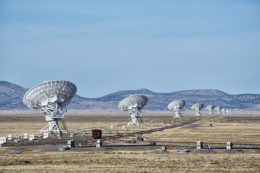
The Karl G. Jansky Very Large Array, located in Socorro, NM. [John Fowler]
The Benefits of Nearby Dwarfs
If you want to learn about the physical properties of low-mass galactic halos, the best place to look is nearby dwarf galaxies. These objects have the benefit of being close enough that we can resolve individual stars, allowing us to explore the relationship between star formation and the surrounding interstellar medium. They also allow us to directly measure bulk velocities, so we can interpret the distributions of both dark and baryonic matt5ter in these galaxies.

HI images of UGC 11411. Left: HI mass surface density. Right: the intensity-weighted velocity field of the HI gas, which reveals the bulk kinematics of the galaxy. [Bralts-Kelly et al. 2017]
A Class in Action
Guided by Professor John Cannon and collaborators at other universities, a class of undergraduates at Macalester College in St. Paul, Minnesota, has coauthored a study of the neutral interstellar medium of these two local dwarf galaxies. The project was made possible by the “Observing for University Classes” program offered by NRAO’s Karl G. Jansky Very Large Array (VLA), in which university classes in observational astronomy can apply for observing time with the VLA.

Top: a view of UGC 11411’s stars from Hubble. Middle: the locations of the galaxy’s star formation, as traced by SAO’s telescope’s observations of Hα. Bottom: UGC 11411’s neutral interstellar medium distribution (red contour), overlaid on the other two data sets. [Bralts-Kelly et al. 2017]
Dominated by Dark Matter
The authors found that in both galaxies, the greatest bulk of the neutral interstellar medium can be found in the same location as the ongoing star formation. The two galaxies are different in several ways, however: UGC 8245 has a much lower star formation rate than UGC 11411 currently, and though the neutral hydrogen gas and stellar masses are similar for both galaxies, UGC 11411 has a halo that is more than an order of magnitude more massive.
They conclude that UGC 8245 — which has a total mass that is only ~2 times larger than its baryonic mass — is very similar to other low-mass galaxies that have been studied in the past. On the other hand, UGC 11411 — which has a total mass that is at least a factor of 10 larger than its baryonic mass — is significantly more massive than other known local low-mass galaxies, and it is unusually highly dark-matter dominated.
Further explorations of these dwarfs in contrast to one another will continue to reveal information about the low-mass galaxies of the universe.
Citation
Lilly Bralts-Kelly et al 2017 ApJL 848 L10. doi:10.3847/2041-8213/aa8ea0


1 Comment
Pingback: nearby low mass galaxies